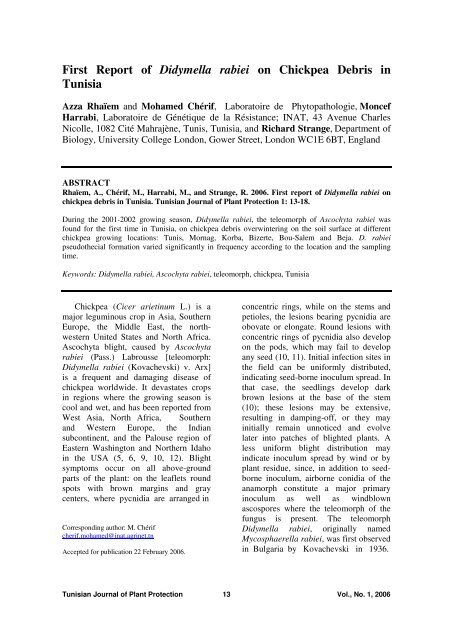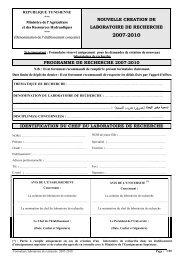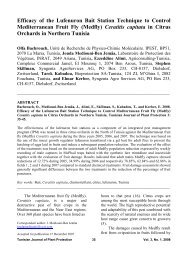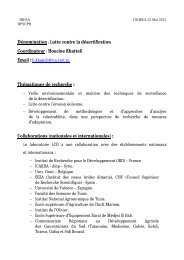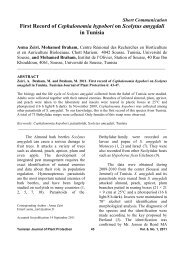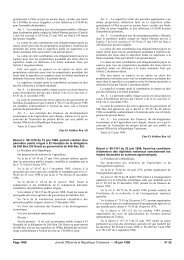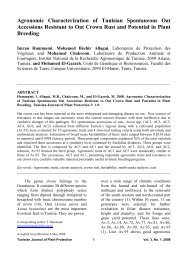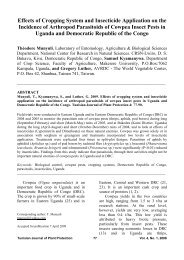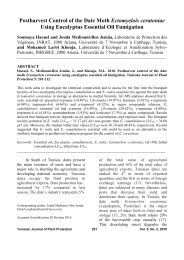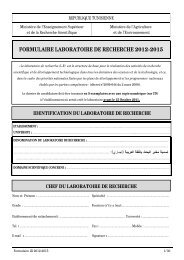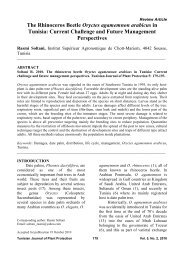First Report of Didymella rabiei on Chickpea Debris in Tunisia - Iresa
First Report of Didymella rabiei on Chickpea Debris in Tunisia - Iresa
First Report of Didymella rabiei on Chickpea Debris in Tunisia - Iresa
Create successful ePaper yourself
Turn your PDF publications into a flip-book with our unique Google optimized e-Paper software.
<str<strong>on</strong>g>First</str<strong>on</strong>g> <str<strong>on</strong>g>Report</str<strong>on</strong>g> <str<strong>on</strong>g>of</str<strong>on</strong>g> <str<strong>on</strong>g>Didymella</str<strong>on</strong>g> <str<strong>on</strong>g>rabiei</str<strong>on</strong>g> <strong>on</strong> <strong>Chickpea</strong> <strong>Debris</strong> <strong>in</strong><br />
<strong>Tunisia</strong><br />
Azza Rhaïem and Mohamed Chérif, Laboratoire de Phytopathologie, M<strong>on</strong>cef<br />
Harrabi, Laboratoire de Génétique de la Résistance; INAT, 43 Avenue Charles<br />
Nicolle, 1082 Cité Mahrajène, Tunis, <strong>Tunisia</strong>, and Richard Strange, Department <str<strong>on</strong>g>of</str<strong>on</strong>g><br />
Biology, University College L<strong>on</strong>d<strong>on</strong>, Gower Street, L<strong>on</strong>d<strong>on</strong> WC1E 6BT, England<br />
ABSTRACT<br />
Rhaïem, A., Chérif, M., Harrabi, M., and Strange, R. 2006. <str<strong>on</strong>g>First</str<strong>on</strong>g> report <str<strong>on</strong>g>of</str<strong>on</strong>g> <str<strong>on</strong>g>Didymella</str<strong>on</strong>g> <str<strong>on</strong>g>rabiei</str<strong>on</strong>g> <strong>on</strong><br />
chickpea debris <strong>in</strong> <strong>Tunisia</strong>. <strong>Tunisia</strong>n Journal <str<strong>on</strong>g>of</str<strong>on</strong>g> Plant Protecti<strong>on</strong> 1: 13-18.<br />
Dur<strong>in</strong>g the 2001-2002 grow<strong>in</strong>g seas<strong>on</strong>, <str<strong>on</strong>g>Didymella</str<strong>on</strong>g> <str<strong>on</strong>g>rabiei</str<strong>on</strong>g>, the teleomorph <str<strong>on</strong>g>of</str<strong>on</strong>g> Ascochyta <str<strong>on</strong>g>rabiei</str<strong>on</strong>g> was<br />
found for the first time <strong>in</strong> <strong>Tunisia</strong>, <strong>on</strong> chickpea debris overw<strong>in</strong>ter<strong>in</strong>g <strong>on</strong> the soil surface at different<br />
chickpea grow<strong>in</strong>g locati<strong>on</strong>s: Tunis, Mornag, Korba, Bizerte, Bou-Salem and Beja. D. <str<strong>on</strong>g>rabiei</str<strong>on</strong>g><br />
pseudothecial formati<strong>on</strong> varied significantly <strong>in</strong> frequency accord<strong>in</strong>g to the locati<strong>on</strong> and the sampl<strong>in</strong>g<br />
time.<br />
Keywords: <str<strong>on</strong>g>Didymella</str<strong>on</strong>g> <str<strong>on</strong>g>rabiei</str<strong>on</strong>g>, Ascochyta <str<strong>on</strong>g>rabiei</str<strong>on</strong>g>, teleomorph, chickpea, <strong>Tunisia</strong><br />
<strong>Chickpea</strong> (Cicer ariet<strong>in</strong>um L.) is a<br />
major legum<strong>in</strong>ous crop <strong>in</strong> Asia, Southern<br />
Europe, the Middle East, the northwestern<br />
United States and North Africa.<br />
Ascochyta blight, caused by Ascochyta<br />
<str<strong>on</strong>g>rabiei</str<strong>on</strong>g> (Pass.) Labrousse [teleomorph:<br />
<str<strong>on</strong>g>Didymella</str<strong>on</strong>g> <str<strong>on</strong>g>rabiei</str<strong>on</strong>g> (Kovachevski) v. Arx]<br />
is a frequent and damag<strong>in</strong>g disease <str<strong>on</strong>g>of</str<strong>on</strong>g><br />
chickpea worldwide. It devastates crops<br />
<strong>in</strong> regi<strong>on</strong>s where the grow<strong>in</strong>g seas<strong>on</strong> is<br />
cool and wet, and has been reported from<br />
West Asia, North Africa, Southern<br />
and Western Europe, the Indian<br />
subc<strong>on</strong>t<strong>in</strong>ent, and the Palouse regi<strong>on</strong> <str<strong>on</strong>g>of</str<strong>on</strong>g><br />
Eastern Wash<strong>in</strong>gt<strong>on</strong> and Northern Idaho<br />
<strong>in</strong> the USA (5, 6, 9, 10, 12). Blight<br />
symptoms occur <strong>on</strong> all above-ground<br />
parts <str<strong>on</strong>g>of</str<strong>on</strong>g> the plant: <strong>on</strong> the leaflets round<br />
spots with brown marg<strong>in</strong>s and gray<br />
centers, where pycnidia are arranged <strong>in</strong><br />
Corresp<strong>on</strong>d<strong>in</strong>g author: M. Chérif<br />
cherif.mohamed@<strong>in</strong>at.agr<strong>in</strong>et.tn<br />
Accepted for publicati<strong>on</strong> 22 February 2006.<br />
c<strong>on</strong>centric r<strong>in</strong>gs, while <strong>on</strong> the stems and<br />
petioles, the lesi<strong>on</strong>s bear<strong>in</strong>g pycnidia are<br />
obovate or el<strong>on</strong>gate. Round lesi<strong>on</strong>s with<br />
c<strong>on</strong>centric r<strong>in</strong>gs <str<strong>on</strong>g>of</str<strong>on</strong>g> pycnidia also develop<br />
<strong>on</strong> the pods, which may fail to develop<br />
any seed (10, 11). Initial <strong>in</strong>fecti<strong>on</strong> sites <strong>in</strong><br />
the field can be uniformly distributed,<br />
<strong>in</strong>dicat<strong>in</strong>g seed-borne <strong>in</strong>oculum spread. In<br />
that case, the seedl<strong>in</strong>gs develop dark<br />
brown lesi<strong>on</strong>s at the base <str<strong>on</strong>g>of</str<strong>on</strong>g> the stem<br />
(10); these lesi<strong>on</strong>s may be extensive,<br />
result<strong>in</strong>g <strong>in</strong> damp<strong>in</strong>g-<str<strong>on</strong>g>of</str<strong>on</strong>g>f, or they may<br />
<strong>in</strong>itially rema<strong>in</strong> unnoticed and evolve<br />
later <strong>in</strong>to patches <str<strong>on</strong>g>of</str<strong>on</strong>g> blighted plants. A<br />
less uniform blight distributi<strong>on</strong> may<br />
<strong>in</strong>dicate <strong>in</strong>oculum spread by w<strong>in</strong>d or by<br />
plant residue, s<strong>in</strong>ce, <strong>in</strong> additi<strong>on</strong> to seedborne<br />
<strong>in</strong>oculum, airborne c<strong>on</strong>idia <str<strong>on</strong>g>of</str<strong>on</strong>g> the<br />
anamorph c<strong>on</strong>stitute a major primary<br />
<strong>in</strong>oculum as well as w<strong>in</strong>dblown<br />
ascospores where the teleomorph <str<strong>on</strong>g>of</str<strong>on</strong>g> the<br />
fungus is present. The teleomorph<br />
<str<strong>on</strong>g>Didymella</str<strong>on</strong>g> <str<strong>on</strong>g>rabiei</str<strong>on</strong>g>, orig<strong>in</strong>ally named<br />
Mycosphaerella <str<strong>on</strong>g>rabiei</str<strong>on</strong>g>, was first observed<br />
<strong>in</strong> Bulgaria by Kovachevski <strong>in</strong> 1936.<br />
<strong>Tunisia</strong>n Journal <str<strong>on</strong>g>of</str<strong>on</strong>g> Plant Protecti<strong>on</strong> 13<br />
Vol., No. 1, 2006
Fruit<strong>in</strong>g bodies were found <strong>on</strong>ly <strong>on</strong><br />
chickpea debris overw<strong>in</strong>ter<strong>in</strong>g <strong>on</strong> field<br />
soil. The teleomorph was then reported <strong>in</strong><br />
Russia, Greece, Hungary, Spa<strong>in</strong>, Syria,<br />
the United States (3, 15), Canada (1) and<br />
Australia (2). D. <str<strong>on</strong>g>rabiei</str<strong>on</strong>g> is heterothallic,<br />
with a bipolar, biallelic <strong>in</strong>compatibility<br />
system (16), and arises from two mat<strong>in</strong>g<br />
types MAT1-1 and MAT1-2. Although<br />
both mat<strong>in</strong>g types have been identified <strong>in</strong><br />
<strong>Tunisia</strong>, <strong>in</strong> naturally <strong>in</strong>fected chickpea<br />
debris ma<strong>in</strong>ta<strong>in</strong>ed under favorable<br />
c<strong>on</strong>diti<strong>on</strong>s <strong>in</strong> the laboratory (4), the<br />
teleomorph has never been reported <strong>in</strong><br />
<strong>Tunisia</strong> <strong>in</strong> the field. The ma<strong>in</strong> objectives<br />
<str<strong>on</strong>g>of</str<strong>on</strong>g> the present study were (i) to determ<strong>in</strong>e<br />
whether the teleomorph <str<strong>on</strong>g>of</str<strong>on</strong>g> the pathogen<br />
and pseudothecial development occur<br />
under field c<strong>on</strong>diti<strong>on</strong>s <strong>in</strong> <strong>Tunisia</strong>, and (ii)<br />
to assess how pseudothecial and pycnidial<br />
formati<strong>on</strong> vary accord<strong>in</strong>g to the locati<strong>on</strong><br />
and the sampl<strong>in</strong>g date.<br />
MATERIALS AND METHODS<br />
Stem debris <str<strong>on</strong>g>of</str<strong>on</strong>g> chickpea plants<br />
naturally <strong>in</strong>fected with A. <str<strong>on</strong>g>rabiei</str<strong>on</strong>g> was<br />
collected from the Oued Mliz regi<strong>on</strong> <strong>in</strong><br />
2001. The stems were air-dried and cut<br />
<strong>in</strong>to 10- to 12-cm-l<strong>on</strong>g pieces each <str<strong>on</strong>g>of</str<strong>on</strong>g><br />
which had at least two necrotic lesi<strong>on</strong>s<br />
with some pycnidia typical <str<strong>on</strong>g>of</str<strong>on</strong>g> Ascochyta<br />
<str<strong>on</strong>g>rabiei</str<strong>on</strong>g>. Nyl<strong>on</strong> net bags (14x20 cm) with a<br />
1.6 mm mesh c<strong>on</strong>ta<strong>in</strong><strong>in</strong>g each twelve<br />
stem pieces were prepared. In November,<br />
these bags were placed <strong>on</strong> the soil <str<strong>on</strong>g>of</str<strong>on</strong>g> 4x3-<br />
m plots at six different locati<strong>on</strong>s (20 bags<br />
per plot). The bags were held <strong>in</strong> place by<br />
a large net attached to the soil to prevent<br />
the bags from be<strong>in</strong>g blown away by the<br />
w<strong>in</strong>d. Plots were located <strong>in</strong> fields <str<strong>on</strong>g>of</str<strong>on</strong>g> the<br />
Experimental Research Stati<strong>on</strong>s at the<br />
follow<strong>in</strong>g locati<strong>on</strong>s: Tunis (Institut<br />
Nati<strong>on</strong>al Agr<strong>on</strong>omique de Tunisie,<br />
INAT), Morneg, Korba, Bizerte, Bou-<br />
Salem, and Beja. For each plot and each<br />
locati<strong>on</strong>, the c<strong>on</strong>tent <str<strong>on</strong>g>of</str<strong>on</strong>g> <strong>on</strong>e bag was<br />
sampled m<strong>on</strong>thly from February to July<br />
2002. Sampled stem pieces were washed<br />
under runn<strong>in</strong>g tap water for 2 mn and<br />
dried <strong>on</strong> filter paper. The density <str<strong>on</strong>g>of</str<strong>on</strong>g> the<br />
fungal fruit<strong>in</strong>g bodies was determ<strong>in</strong>ed <strong>on</strong><br />
three stem pieces per bag by calculat<strong>in</strong>g<br />
the number <str<strong>on</strong>g>of</str<strong>on</strong>g> pycnidia and pseudothecia<br />
per square cm <str<strong>on</strong>g>of</str<strong>on</strong>g> tissue under a dissect<strong>in</strong>g<br />
microscope at 80X. The fruit<strong>in</strong>g bodies <str<strong>on</strong>g>of</str<strong>on</strong>g><br />
each <str<strong>on</strong>g>of</str<strong>on</strong>g> these stem pieces were removed,<br />
squashed <strong>in</strong> lactophenol-acid fuchs<strong>in</strong>,<br />
exam<strong>in</strong>ed under a microscope at 400X<br />
and characterised as pycnidia or<br />
pseudothecia <strong>in</strong> ten microscope fields<br />
(0.278 mm² each). The total number <str<strong>on</strong>g>of</str<strong>on</strong>g><br />
pycnidia and pseudothecia was calculated<br />
for each sampled stem piece.<br />
RESULTS<br />
<str<strong>on</strong>g>Didymella</str<strong>on</strong>g> <str<strong>on</strong>g>rabiei</str<strong>on</strong>g> pseudothecia<br />
occurred <strong>on</strong> all chickpea debris from all<br />
six locati<strong>on</strong>s <strong>in</strong> <strong>Tunisia</strong>. Typical darkbrown<br />
to black pseudothecia with<br />
perceptible beacks and ostioles (Fig. 1. A,<br />
B) c<strong>on</strong>ta<strong>in</strong><strong>in</strong>g parallel arranged asci were<br />
observed (Fig. 1. C). Pseudothecial<br />
dimensi<strong>on</strong>s ranged from 76-152 x 120-<br />
250 µm,. Asci were cyl<strong>in</strong>drical-calvate,<br />
pedicellate, bitunicate, narrow (Fig. 1. D)<br />
and c<strong>on</strong>ta<strong>in</strong>ed l<strong>in</strong>early arranged<br />
ascospores (eight) each <str<strong>on</strong>g>of</str<strong>on</strong>g> which was<br />
divided <strong>in</strong>to two unequal cells with a very<br />
clear c<strong>on</strong>stricti<strong>on</strong> at the septum (Fig. 1.<br />
D). Ascospore size was 13.5-17.25x6-<br />
6.75 µm and ascus size 48-50 x 10-12<br />
µm. In additi<strong>on</strong> to the typical asci, wide<br />
flask-shaped asci were also observed<br />
(Fig. 1. E).<br />
The fungus grew saprophytically <strong>on</strong><br />
the stem debris and formed asexual<br />
fructificati<strong>on</strong>s (pycnidia) as well as sexual<br />
fructificati<strong>on</strong>s (pseudothecia) with<strong>in</strong> 8 to<br />
12 weeks after placement <strong>on</strong> the soil.<br />
Before February, no pseudothecia were<br />
found <strong>on</strong> any stem debris, at any locati<strong>on</strong>.<br />
By February, the first pseudothecia<br />
started to appear <strong>on</strong> debris from Korba<br />
and Bou-Salem. The extent <str<strong>on</strong>g>of</str<strong>on</strong>g><br />
pseudothecial and pycnidial formati<strong>on</strong>s<br />
varied accord<strong>in</strong>g to locati<strong>on</strong>s but both<br />
sexual and asexual fruit<strong>in</strong>g bodies could<br />
be recorded until June and July <strong>in</strong> all the<br />
studied locati<strong>on</strong>s (Fig. 2). The<br />
exam<strong>in</strong>ati<strong>on</strong> <str<strong>on</strong>g>of</str<strong>on</strong>g> Ascochyta fruit<strong>in</strong>g body<br />
<strong>Tunisia</strong>n Journal <str<strong>on</strong>g>of</str<strong>on</strong>g> Plant Protecti<strong>on</strong> 14<br />
Vol., No. 1, 2006
Fig. 1. Sexual fruit<strong>in</strong>g bodies <str<strong>on</strong>g>of</str<strong>on</strong>g> <str<strong>on</strong>g>Didymella</str<strong>on</strong>g> <str<strong>on</strong>g>rabiei</str<strong>on</strong>g> A, B, Pseudothecia with beack and ostiole (x400); C,<br />
Pseudothecium with asci (x400); D, Ascus with ascospores (x1000); E, Flask-shaped asci with ascospores (x400).<br />
<strong>Tunisia</strong>n Journal <str<strong>on</strong>g>of</str<strong>on</strong>g> Plant Protecti<strong>on</strong> 15<br />
Vol., No. 1, 2006
development <strong>on</strong> stem pieces overw<strong>in</strong>ter<strong>in</strong>g<br />
<strong>on</strong> the soil revealed that the<br />
density <str<strong>on</strong>g>of</str<strong>on</strong>g> fruit<strong>in</strong>g bodies varied<br />
significantly with the locati<strong>on</strong> and the<br />
sampl<strong>in</strong>g date (Table 1). Pseudothecia<br />
density as a percentage <str<strong>on</strong>g>of</str<strong>on</strong>g> the density <str<strong>on</strong>g>of</str<strong>on</strong>g><br />
all Ascochyta fruit<strong>in</strong>g bodies formed <strong>on</strong><br />
stem debris was 43.4 % <strong>in</strong> Korba, 46.4 %<br />
<strong>in</strong> Bizerte, 44.9 % <strong>in</strong> Tunis, 22.7 % <strong>in</strong><br />
Morneg, 35.7 % <strong>in</strong> Bou-Salem, and 32.9<br />
% <strong>in</strong> Beja. Fig. 3 further shows that<br />
pseudothecial formati<strong>on</strong> was more<br />
important <strong>in</strong> Korba, Bizerte and Tunis<br />
than <strong>in</strong> Morneg, Bou-Salem, and Beja,<br />
whereas <strong>in</strong> the last three locati<strong>on</strong>s more<br />
pycnidia were formed.<br />
D e n s ity p e r cm ²<br />
600<br />
500<br />
400<br />
300<br />
200<br />
100<br />
0<br />
Pycnidia<br />
Pseudothecia<br />
Feb Mar Apr May Jun Jul<br />
Period<br />
Fig. 2. Mean density <str<strong>on</strong>g>of</str<strong>on</strong>g> sexual and asexual fruit<strong>in</strong>g<br />
bodies formed <strong>on</strong> chickpea debris from February to<br />
July 2002 (I = standard error).<br />
Density per cm ²<br />
600<br />
500<br />
400<br />
300<br />
200<br />
100<br />
0<br />
Korba Bizerte Tunis Morneg Bousalem Beja<br />
Locati<strong>on</strong><br />
Pycnidia<br />
Pseudothecia<br />
Fig. 3. Mean density <str<strong>on</strong>g>of</str<strong>on</strong>g> sexual and asexual fruit<strong>in</strong>g<br />
bodies formed <strong>on</strong> chickpea debris at six locati<strong>on</strong>s <strong>in</strong><br />
<strong>Tunisia</strong> (I = standard error).<br />
DISCUSSION<br />
The morphological characteristics <str<strong>on</strong>g>of</str<strong>on</strong>g><br />
pseudothecia (Fig. 1. A-C), asci and<br />
ascospores (Figs. 1. C-E) observed <strong>in</strong> the<br />
six studied locati<strong>on</strong>s c<strong>on</strong>firmed the<br />
fungus to be D. <str<strong>on</strong>g>rabiei</str<strong>on</strong>g>. Pseudothecial<br />
dimensi<strong>on</strong>s were c<strong>on</strong>sistent with those<br />
reported by Nene (9) and Nene and<br />
Reddy (10). The characteristics <str<strong>on</strong>g>of</str<strong>on</strong>g> asci<br />
and ascospores, <strong>in</strong>clud<strong>in</strong>g shape, size as<br />
well as number and arrangement <str<strong>on</strong>g>of</str<strong>on</strong>g><br />
ascospores are c<strong>on</strong>sistent with those<br />
reported for D. <str<strong>on</strong>g>rabiei</str<strong>on</strong>g> (9, 10, 13). Wide<br />
flask-shaped asci, which were observed <strong>in</strong><br />
additi<strong>on</strong> to the typical asci are similar to<br />
those reported by Armstr<strong>on</strong>g et al. (1) <strong>in</strong><br />
Canada.<br />
Sexual fruit<strong>in</strong>g bodies <str<strong>on</strong>g>of</str<strong>on</strong>g> the fungus<br />
could be observed <strong>in</strong> the six <strong>Tunisia</strong>n<br />
locati<strong>on</strong>s from February to July. These<br />
results are similar to those reported by<br />
Navas-Cortés et al. (7) who showed the<br />
presence <str<strong>on</strong>g>of</str<strong>on</strong>g> pseudothetia <strong>on</strong> chickpea<br />
debris until July <strong>in</strong> different locati<strong>on</strong>s <strong>in</strong><br />
Spa<strong>in</strong>. Our studies revealed that the<br />
locati<strong>on</strong>s <str<strong>on</strong>g>of</str<strong>on</strong>g> Korba, Bizerte and Tunis<br />
were more favorable to pseudothecia<br />
formati<strong>on</strong> than Morneg, Bou-Salem, and<br />
Beja. These differences may be related<br />
ma<strong>in</strong>ly to weather c<strong>on</strong>diti<strong>on</strong>s prevail<strong>in</strong>g<br />
<strong>in</strong> each locati<strong>on</strong>. In fact, relative humidity<br />
(RH) has been shown <strong>in</strong> previous studies<br />
to be the most important factor that<br />
<strong>in</strong>fluences fungal development (8, 14).<br />
Pycnidia and pseudothecia <str<strong>on</strong>g>of</str<strong>on</strong>g> the<br />
pathogen have been reported to develop<br />
under humid c<strong>on</strong>diti<strong>on</strong>s but the<br />
maturati<strong>on</strong> <str<strong>on</strong>g>of</str<strong>on</strong>g> pseudothecia, <strong>in</strong> particular,<br />
is delayed by extended periods <str<strong>on</strong>g>of</str<strong>on</strong>g><br />
drought. When RH is not a limit<strong>in</strong>g<br />
factor, the effect <str<strong>on</strong>g>of</str<strong>on</strong>g> temperature <strong>on</strong> the<br />
further development <str<strong>on</strong>g>of</str<strong>on</strong>g> pseudothecia has<br />
been found to vary with the pseudothetial<br />
developmental stage and with the type <str<strong>on</strong>g>of</str<strong>on</strong>g><br />
debris (naturally <strong>in</strong>fected or artificially<br />
<strong>in</strong>fected) <strong>on</strong> which pseudothecia formed<br />
(8). This suggests that <strong>in</strong> the locati<strong>on</strong>s <str<strong>on</strong>g>of</str<strong>on</strong>g><br />
<strong>Tunisia</strong>n Journal <str<strong>on</strong>g>of</str<strong>on</strong>g> Plant Protecti<strong>on</strong> 16<br />
Vol., No. 1, 2006
Table 1. Mean squares <str<strong>on</strong>g>of</str<strong>on</strong>g> the density (number/cm 2 ) <str<strong>on</strong>g>of</str<strong>on</strong>g> all Ascochyta fruit<strong>in</strong>g bodies, pseudothecia and pycnidia<br />
developed <strong>on</strong> naturally <strong>in</strong>fected debris placed at 6 locati<strong>on</strong>s <strong>in</strong> <strong>Tunisia</strong> and assessed from February to July 2002 at<br />
m<strong>on</strong>thly <strong>in</strong>tervals<br />
Sources <str<strong>on</strong>g>of</str<strong>on</strong>g><br />
MS<br />
Df<br />
variati<strong>on</strong><br />
Fruit<strong>in</strong>g bodies Pseudothecia Pycnidia<br />
Locati<strong>on</strong> (L) 5 87331,0 43203,20 * 129076,8 **<br />
Time (T) 5 33604,1 72829,17 ** 152556,5***<br />
L x T 25 100011,7 * 30834,43 * 59566,7**<br />
Residue 72 50129,45 17065,46 28643,46<br />
* significant at 0,01
______________________________________________________________<br />
<str<strong>on</strong>g>Didymella</str<strong>on</strong>g> <str<strong>on</strong>g>rabiei</str<strong>on</strong>g> على<br />
.2006<br />
.<strong>Tunisia</strong>n Journal <str<strong>on</strong>g>of</str<strong>on</strong>g> Plant Protecti<strong>on</strong> 1: 13-18<br />
ملخص<br />
رحيّم، عزّة، محمد الشریف، منصف الهرابي وریتشارد سترانج.<br />
بقایا الحمص في تونس.<br />
أول ملاحظة للفطر<br />
للفطر<br />
خلال الموسم الزراعي 2002-2001، تمكنا من تشخيص الطور الجنسي<br />
للمرة الأولى في تونس. تمت خلال هذه الدراسة معاینة الفطر على بقایا حمص مصاب بالمرض وضعت على<br />
سطح الأرض في ست مناطق زراعية للحمص في تونس وهي مرناق، قربة، بنزرت، بوسالم، باجة وتونس. وقد تفاوت<br />
عدد الثمار الأسكية الحجيریة بصورة معنویة بين المناطق وعبر الزمن خلال فترة الدراسة.<br />
Ascochyta<br />
<str<strong>on</strong>g>Didymella</str<strong>on</strong>g> <str<strong>on</strong>g>rabiei</str<strong>on</strong>g><br />
<str<strong>on</strong>g>rabiei</str<strong>on</strong>g><br />
آلمات مفاتيح: ،<str<strong>on</strong>g>Didymella</str<strong>on</strong>g> <str<strong>on</strong>g>rabiei</str<strong>on</strong>g> ،Ascochyta <str<strong>on</strong>g>rabiei</str<strong>on</strong>g> طور جنسي، حمص، تونس<br />
LITERATURE CITED<br />
1. Armstr<strong>on</strong>g, C.L., Ch<strong>on</strong>go, G., Gossen, B.D., and<br />
Duczek, L.J. 2001. Mat<strong>in</strong>g type distributi<strong>on</strong> and<br />
<strong>in</strong>cidence <str<strong>on</strong>g>of</str<strong>on</strong>g> the teleomorph <str<strong>on</strong>g>of</str<strong>on</strong>g> Ascochyta <str<strong>on</strong>g>rabiei</str<strong>on</strong>g><br />
(<str<strong>on</strong>g>Didymella</str<strong>on</strong>g> <str<strong>on</strong>g>rabiei</str<strong>on</strong>g>) <strong>in</strong> Canada. Canadian Journal<br />
<str<strong>on</strong>g>of</str<strong>on</strong>g> Plant Pathology 23: 110-113.<br />
2. Galloway, J. and MacLeod, W. J., 2003.<br />
<str<strong>on</strong>g>Didymella</str<strong>on</strong>g> <str<strong>on</strong>g>rabiei</str<strong>on</strong>g>, the teleomorph <str<strong>on</strong>g>of</str<strong>on</strong>g> Ascochyta<br />
<str<strong>on</strong>g>rabiei</str<strong>on</strong>g>, found <strong>on</strong> chickpea stubble <strong>in</strong> Western<br />
Australia. Australian Plant Pathology 32: 127-<br />
128.<br />
3. Kaiser, W.J. 1997. The teleomorph <str<strong>on</strong>g>of</str<strong>on</strong>g> Ascochyta<br />
<str<strong>on</strong>g>rabiei</str<strong>on</strong>g> and its significance <strong>in</strong> breed<strong>in</strong>g chickpea.<br />
Pages 3-21, In: DNA Markers and Breed<strong>in</strong>g for<br />
Resistance to Ascochyta Blight <strong>in</strong> <strong>Chickpea</strong> (S.M.<br />
Udupa & F. Weigand Editi<strong>on</strong>s) - Proceed<strong>in</strong>g <str<strong>on</strong>g>of</str<strong>on</strong>g><br />
the Symposium <strong>on</strong> “Applicati<strong>on</strong> <str<strong>on</strong>g>of</str<strong>on</strong>g> DNA<br />
f<strong>in</strong>gerpr<strong>in</strong>t<strong>in</strong>g for crop improvement: Markerassisted<br />
Selecti<strong>on</strong> <str<strong>on</strong>g>of</str<strong>on</strong>g> <strong>Chickpea</strong> for Susta<strong>in</strong>able<br />
Agriculture <strong>in</strong> the Dry Areas, 11-12 April 1994,<br />
ICARDA, Aleppo, Syria,.<br />
4. Kaiser, W.J. 1995. World distributi<strong>on</strong> <str<strong>on</strong>g>of</str<strong>on</strong>g><br />
<str<strong>on</strong>g>Didymella</str<strong>on</strong>g> <str<strong>on</strong>g>rabiei</str<strong>on</strong>g>, the teleomorph <str<strong>on</strong>g>of</str<strong>on</strong>g> Ascochyta<br />
<str<strong>on</strong>g>rabiei</str<strong>on</strong>g>, <strong>on</strong> chickpea. Phytopathology 85: 1040<br />
(abstract).<br />
5. Kaiser, W.J. 1992. Epidemiology <str<strong>on</strong>g>of</str<strong>on</strong>g> Ascochyta<br />
<str<strong>on</strong>g>rabiei</str<strong>on</strong>g>. In: Disease Resistance Breed<strong>in</strong>g <strong>in</strong><br />
<strong>Chickpea</strong>. K.B. S<strong>in</strong>gh & M. C. Saxena Editi<strong>on</strong>s,<br />
ICARDA, Aleppo, Syria, 117-134.<br />
6. Kaiser, W.J. and Muelbauer, F.J. 1988. An<br />
outbreak <str<strong>on</strong>g>of</str<strong>on</strong>g> Ascochyta blight <str<strong>on</strong>g>of</str<strong>on</strong>g> chickpea <strong>in</strong> the<br />
Pacific Northwest, USA, <strong>in</strong> 1987. Internati<strong>on</strong>al<br />
<strong>Chickpea</strong> Newsletter 18: 16-17.<br />
7. Navas-Cortés, J. A., Trapero-Casas, A., and<br />
Jimenés-Dias, R. M., 1998. Phenology <str<strong>on</strong>g>of</str<strong>on</strong>g><br />
<str<strong>on</strong>g>Didymella</str<strong>on</strong>g> <str<strong>on</strong>g>rabiei</str<strong>on</strong>g> development <strong>on</strong> chickpea debris<br />
under field c<strong>on</strong>diti<strong>on</strong>s <strong>in</strong> Spa<strong>in</strong>. Phytopathology<br />
88 (9): 983-991.<br />
8. Navas-Cortés, J. A., Trapero-Casas, A., and<br />
Jimenés-Dias, R. M., 1998. Influence <str<strong>on</strong>g>of</str<strong>on</strong>g> relative<br />
humidity and temperature <strong>on</strong> development <str<strong>on</strong>g>of</str<strong>on</strong>g><br />
<str<strong>on</strong>g>Didymella</str<strong>on</strong>g> <str<strong>on</strong>g>rabiei</str<strong>on</strong>g> <strong>on</strong> chickpea debris. Plant<br />
Pathology 47: 57-66.<br />
9. Nene, Y.L. 1982. Review <str<strong>on</strong>g>of</str<strong>on</strong>g> Ascochyta blight <str<strong>on</strong>g>of</str<strong>on</strong>g><br />
chickpea. Tropical Pest Management. 28: 61-70.<br />
10. Nene, Y. and Reddy, M.V.1987. <strong>Chickpea</strong><br />
diseases and their c<strong>on</strong>trol. In: The <strong>Chickpea</strong><br />
(M.C. Saxena & K.B. S<strong>in</strong>gh Editi<strong>on</strong>s.),<br />
Comm<strong>on</strong>wealth Agricultural Bureaux<br />
Internati<strong>on</strong>al, Ox<strong>on</strong>, UK, 233-270.<br />
11. Nene, Y.L., Reddy, M.V., Haware, M.P.,<br />
Ghanekar, A.M., and Am<strong>in</strong>, K.S. 1991. Field<br />
Diagnosis <str<strong>on</strong>g>of</str<strong>on</strong>g> <strong>Chickpea</strong> Diseases and their<br />
C<strong>on</strong>trol. Informati<strong>on</strong> bullet<strong>in</strong> n° 28, Internati<strong>on</strong>al<br />
Crop Research Institute for Semi-Arid Tropics,<br />
India, 51 pp.<br />
12. Saxena, M.C. and S<strong>in</strong>gh, K.B., 1984. Ascochyta<br />
blight and w<strong>in</strong>ter sow<strong>in</strong>g <str<strong>on</strong>g>of</str<strong>on</strong>g> chickpeas. Mart<strong>in</strong>us<br />
Nijh<str<strong>on</strong>g>of</str<strong>on</strong>g>f/ W. Junk Publishers, The Hague,<br />
Netherlands.<br />
13. Trapero-Casas, A. and Kaiser, W. J. 1992.<br />
Development <str<strong>on</strong>g>of</str<strong>on</strong>g> <str<strong>on</strong>g>Didymella</str<strong>on</strong>g> <str<strong>on</strong>g>rabiei</str<strong>on</strong>g>, the<br />
teleomorph <str<strong>on</strong>g>of</str<strong>on</strong>g> Ascochyta <str<strong>on</strong>g>rabiei</str<strong>on</strong>g>, <strong>on</strong> chickpea<br />
straw. Phytopathology 82 (11): 1261-1266.<br />
14. Trapero-Casas, A. and Kaiser, W. J. 1987.<br />
Factors <strong>in</strong>fluenc<strong>in</strong>g the development <str<strong>on</strong>g>of</str<strong>on</strong>g> the<br />
teleomorph <str<strong>on</strong>g>Didymella</str<strong>on</strong>g> <str<strong>on</strong>g>rabiei</str<strong>on</strong>g>. ICN 17: 27-28.<br />
15. Trapero-Casas A., Navas-Cortés, J. A. and<br />
Jiménez-Diaz, R. M., 1996. Airborne ascospores<br />
<str<strong>on</strong>g>of</str<strong>on</strong>g> <str<strong>on</strong>g>Didymella</str<strong>on</strong>g> <str<strong>on</strong>g>rabiei</str<strong>on</strong>g> as a major primary <strong>in</strong>oculum<br />
for Ascochyta blight epidemics <strong>in</strong> chickpea crops<br />
<strong>in</strong> Southern Spa<strong>in</strong>. European Journal <str<strong>on</strong>g>of</str<strong>on</strong>g> Plant<br />
Pathology 102: 237-245.<br />
16. Wils<strong>on</strong>, A.D. and Kaiser, W.J. 1995. Cytology<br />
and genetics <str<strong>on</strong>g>of</str<strong>on</strong>g> sexual <strong>in</strong>compatibility <strong>in</strong><br />
<str<strong>on</strong>g>Didymella</str<strong>on</strong>g> <str<strong>on</strong>g>rabiei</str<strong>on</strong>g>. Mycologia 87(6): 795-804.<br />
_____________________<br />
<strong>Tunisia</strong>n Journal <str<strong>on</strong>g>of</str<strong>on</strong>g> Plant Protecti<strong>on</strong> 18<br />
Vol., No. 1, 2006


